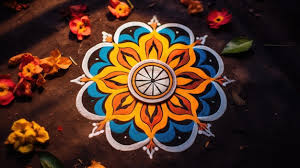Kolam is a traditional and cultural art form practiced predominantly in South India. Margazhi is an auspicious month that begins in mid-December and ends in mid-January. One of the attractions of Kolam using rice flour is to feed the ants, but the most important thing is to improve the health of our body. It involves creating intricate and colorful patterns on the ground, typically at the entrance of homes, using materials such as rice flour, chalk, or colored powders. The tradition of drawing kolam holds cultural, social, and symbolic significance.

Kolam is deeply rooted in South Indian culture and is an integral part of daily life. It is considered a form of artistic expression that transcends generations, connecting families and communities. Many South Indian households practice the tradition of drawing kolam as a daily ritual. It is often done in the early morning, and the designs can vary based on the occasion, season, or personal preferences.
Kolam patterns often carry symbolic meanings and are believed to bring good luck, prosperity, and positive energy to the home. Certain designs may be drawn during specific festivals or celebrations, signifying auspicious beginnings. Drawing kolam is a communal activity that fosters a sense of togetherness and community. During festivals and special occasions, neighbors and family members may gather to create elaborate kolam designs together.
Kolam designs often incorporate mathematical and geometric elements. The arrangement of dots, lines, and shapes follows specific rules, and artists use spatial reasoning to create balanced and symmetrical patterns.
Kolam is a form of artistic expression that allows individuals to showcase their creativity and skills. Artists may innovate and adapt traditional patterns or create entirely new designs. The choice of kolam designs can vary with seasons and festivals. For example, during the harvest festival of Pongal, kolams depicting rice pots, sugarcane, and traditional symbols associated with the festival are commonly drawn.
Drawing kolam is often considered a meditative practice. The repetitive nature of creating intricate patterns can be calming and meditative, providing a moment of mindfulness in daily life. One unique aspect of kolam is its transient nature. The designs are created on the ground, and they may be washed away or erased throughout the day. This impermanence symbolizes the transient nature of life.
While kolam has deep traditional roots, it has also evolved over time. Artists may incorporate contemporary elements, and the practice continues to be dynamic, reflecting changing tastes and influences.
Overall, the tradition of drawing kolam is a vibrant and multifaceted cultural practice that encompasses art, mathematics, spirituality, and community engagement. It is a living tradition that continues to be cherished and passed down through generations in South India.